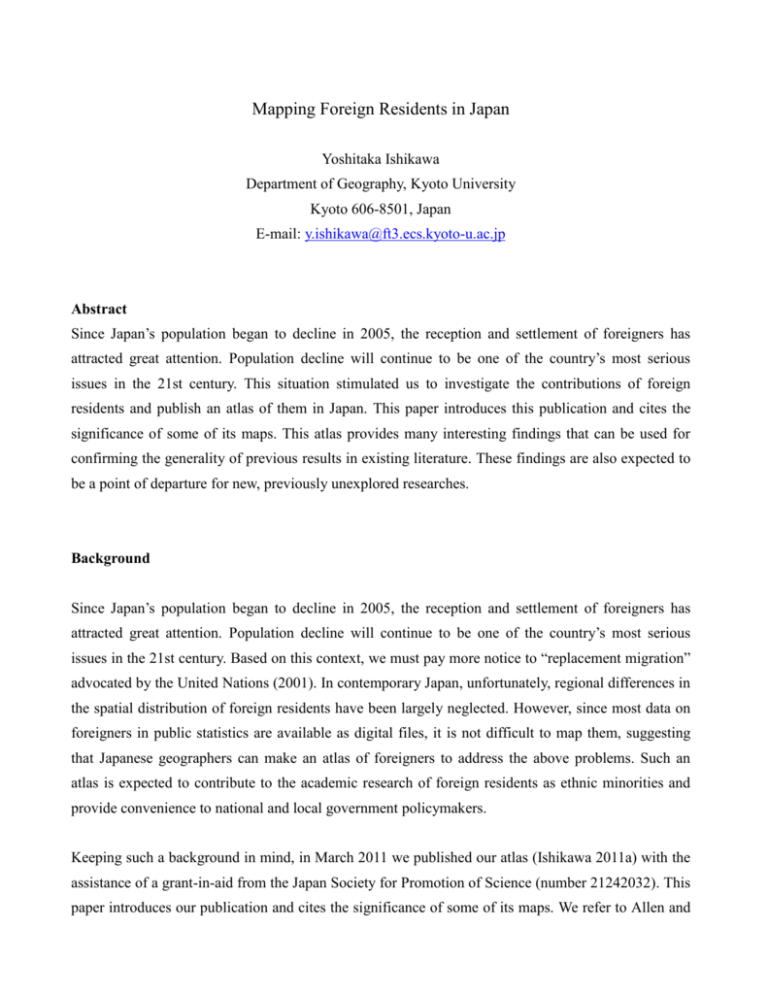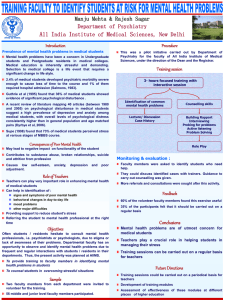
Mapping Foreign Residents in Japan
Yoshitaka Ishikawa
Department of Geography, Kyoto University
Kyoto 606-8501, Japan
E-mail: y.ishikawa@ft3.ecs.kyoto-u.ac.jp
Abstract
Since Japan’s population began to decline in 2005, the reception and settlement of foreigners has
attracted great attention. Population decline will continue to be one of the country’s most serious
issues in the 21st century. This situation stimulated us to investigate the contributions of foreign
residents and publish an atlas of them in Japan. This paper introduces this publication and cites the
significance of some of its maps. This atlas provides many interesting findings that can be used for
confirming the generality of previous results in existing literature. These findings are also expected to
be a point of departure for new, previously unexplored researches.
Background
Since Japan’s population began to decline in 2005, the reception and settlement of foreigners has
attracted great attention. Population decline will continue to be one of the country’s most serious
issues in the 21st century. Based on this context, we must pay more notice to “replacement migration”
advocated by the United Nations (2001). In contemporary Japan, unfortunately, regional differences in
the spatial distribution of foreign residents have been largely neglected. However, since most data on
foreigners in public statistics are available as digital files, it is not difficult to map them, suggesting
that Japanese geographers can make an atlas of foreigners to address the above problems. Such an
atlas is expected to contribute to the academic research of foreign residents as ethnic minorities and
provide convenience to national and local government policymakers.
Keeping such a background in mind, in March 2011 we published our atlas (Ishikawa 2011a) with the
assistance of a grant-in-aid from the Japan Society for Promotion of Science (number 21242032). This
paper introduces our publication and cites the significance of some of its maps. We refer to Allen and
Turner (2002) who showed detailed ethnic maps based on census tracts in Southern California and
stimulated us to issue a similar publication, although our background is widely different.
Structure
This publication consists of the following chapters: “postwar chronological table in relation to
foreigners,” “general explanation of maps,” “main part,” “definition of data mapped,” and
“references.” The main part contains six sections: ‘spatial distribution and its changes,’ ‘gender, age,
and nationality,’ ‘residence status,’ ‘work,’ ‘life,’ and ‘residential concentration and migration.’ Each
section contains a few subsections, including more than one hundred colorful maps. The main part
consists of thirty subsections and short explanations to each. These maps in the main part are drawn
chiefly from such public statistics as the Population Census of Japan, Statistics on Foreigners
Registered in Japan, and the Vital Statistics of Japan. Micro data from the 2005 Population Census,
especially provided from Japan’s Statistics Bureau, are utilized as well.
While most of the maps in the atlas are nation-wide by prefecture/municipality, some are drawn on a
cho-cho-aza (minimum unit of Japanese census tract) basis for ordinance-designated cities and
members of the conference of cities with a foreigner concentration in the ‘residential concentration
and migration’ subsection. Additionally, interesting maps shown in previous literature are reprinted,
and good photographs and small figures/tables are also inserted.
Examples
Five maps are introduced here as examples and their significance is explained. Since the original atlas
was written in Japanese, the maps were reprinted without changes. However, the characters 平均値
(average) and 標準偏差 (standard deviation) in Figures 1, 2, 3 and 5 will help explain them.
Rate of foreign residents
In response to the labor force shortages during the economic boom of the late 1980s, the influx of
foreign residents to Japan increased sharply. This trend continued during the recessionary period of the
1990s mainly due to large wage differences between Japan and their native countries and their
expanding social networks in Japan. Figure 1 shows the rate of the numbers of foreigners to the total
population in 2005, a basic measure of foreign residents in a country. The national average is 0.81%,
which is much lower than the rates reported in most OECD countries.
The places of the residences of the foreign populations are not evenly distributed throughout Japan.
They tend to concentrate in the central part of the country mainly due to rich employment opportunities,
including the three largest metropolitan areas: Tokyo, Nagoya, and Osaka. If we decompose this by
nationality, a more complicated but interesting situation appears among major nationalities. Note that
while the Japanese population as an ethnic majority shows a remarkable concentration into the Tokyo
area, exemplified by the popular term “mono-polar concentration into Tokyo,” the foreign population
represents a somewhat different pattern; as a manufacturing stronghold, the Nagoya area and its
vicinity have much greater importance.
Figure 1. Rate of foreign residents
Sex ratio
Figure 2 depicts the sex ratio of foreign residents by municipality in 2005. To avoid abnormal values,
municipalities with fewer than ten foreigners have no coloration. This measure shows the number of
males per 100 females, and the national average is 73.1. However, the map depicts a great difference in
different parts of the country. The ratio is relatively balanced in the three largest metropolitan areas.
But in the peripheral areas, where serious population decline exists, smaller values under 50.0 are more
common, implying a greatly female-dominated situation. This finding suggests that the influx of
foreign women to the peripheral regions probably reflects international marriage with Japanese men
experiencing a marriage squeeze in terms of the availability of Japanese women. Such an influx has
slightly mitigated the decrease of the Japanese population there (Ishikawa 2011b). We need to carefully
confirm this conjecture.
Figure 2. Sex ratio
Rate of self-employed
Figure 3 reveals the rate of the self-employed to the total number of employed persons. The
occupation of foreign residents is an important research topic, because establishing independent jobs
is generally a major goal of foreign residents in Japan; however, such data remain unavailable from
published official statistics. This map is drawn from the micro data of Japan’s 2005 census. Even
though the rate in eastern Japan is rather low, it is higher in the Osaka metropolitan area including
Osaka and Kyoto and the two western prefectures of Fukuoka and Yamaguchi; these correspond to
areas that show a concentration of Korean population as “old-comers.” This suggests that the
movement for establishing independent businesses is much less conspicuous among the “new-comers”
from China, Brazil, and the Philippines.
Figure 3. Rate of self-employed
Number of foreign children who need to learn Japanese
According to the School Basic Survey, the number of foreign pupils at elementary and junior high
schools in Japan is 68,000. However, unfortunately, some foreign school-age children do not attend
school. Furthermore, since an increasing number of the foreign children who should attend school in
Japan needs the teaching of Japanese, local schools are trying to help them keep pace with the school
curriculum.
The number of foreign school-age children who need such teaching is shown by prefecture and mother
tongue in Figure 4. The data source is a 2008 survey by Japan’s Ministry of Education, Culture, Sports,
Science and Technology. Such children tend to concentrate in the three largest metropolitan areas,
reflecting the spatial distribution of the foreign population as a whole. However, there is a salient
feature in terms of their mother tongue. Foreign children who speak Chinese ( 中 国 語 ) are
conspicuous in Tokyo, Kanagawa, and Chiba in the Tokyo area and in Hyogo in the Osaka area. Those
who speak Portuguese (ポルトガル語) are notable in the prefectures of Aichi, Shizuoka, Mie, Gifu,
and Shiga, where the Brazilian population is predominant, and the spatial pattern of those who speak
Spanish (スペイン語) resembles that of the Portuguese speakers. Therefore, the teaching of Japanese
has to be provided carefully by keeping this feature in mind.
Figure 4. Foreign children who need to learn Japanese
Rate of public house dwellers
The type of housing of foreign residents is also an important research concern. Similar to the Japanese
population, the Korean population as “old-comers” shows a high rate of owning houses, but foreign
residents of other nationalities largely tend to rent. A particularly important question in this context is
whether a high rate of living in public houses provided by municipalities is observed, because a
certain part of immigrants in western European countries reside in such houses (Knox and Pinch 2000).
A few recent reports have elucidated the actual dwelling situation by foreign residents in Japan’s
public houses, but the nationwide importance of such houses remains unexplored mainly due to the
unavailability of published official statistics.
Figure 5. Rate of public house dwellers
Figure 5, drawn from the micro data of the 2005 census, reveals the rate of foreign dwellers in public
houses by municipality. To avoid abnormal values, municipalities with fewer than ten foreigners have
no coloration. The public houses here denote housing owned by local governments, incorporated
administrative agencies, or public corporations. Municipalities with higher rates are prominent in the
prefectures of Aichi and Shizuoka, which are known for concentrations of foreign populations,
particularly Brazilians. Therefore, we infer that the Brazilian population generally has a higher rate of
occupying public housing than other foreign populations. Municipalities with 25.2% or more are small
but they are dispersed even in the peripheral regions. This suggests that public housing serves to
benefit foreign residents who often experience discrimination or prejudice in their search for housing
in Japan.
Concluding Remarks
This paper introduced an atlas of foreign residents in Japan and cited the significance of some of its
maps. Although the atlas contains over 100 maps, just a few are presented here due to space
limitations. The maps give many interesting findings that can be used for confirming the generality of
previous results in existing literature and are expected to be a point of departure for new, previously
unexplored researches. We hope this atlas will assist research of foreign residents in Japan. Our next
research task addresses how we can specifically contribute to policy-making associated with the
settlement and social integration of foreign residents in Japan with this atlas.
Bibliography
Allen, J. P. and Turner, E. 2002. Changing faces, changing places: Mapping Southern Californians,
Northridge, California: The Center for Geographical Studies, California State University at
Northridge.
Ishikawa, Y. ed. 2011a, Chizu de miru nihon no gaikoku-jin (Mapping foreign residents in
Japan), Kyoto: Nakanishiya Publishing Co.
Ishikawa, Y. 2011b, Recent in-migration to peripheral regions of Japan in the context of
incipient national population decline, in Coulmas, F. and Lützeler, R. eds., Imploding
populations in Japan and Germany, Leiden and Boston: Brill, 420-442.
Knox, P. and Pinch, S. 2000, Urban social geography: An introduction, Harlow: Pearson/Prentice
Hall.
United Nations, 2001, Replacement migration: Is it a solution to declining and ageing
Populations?, New York: United Nations.








